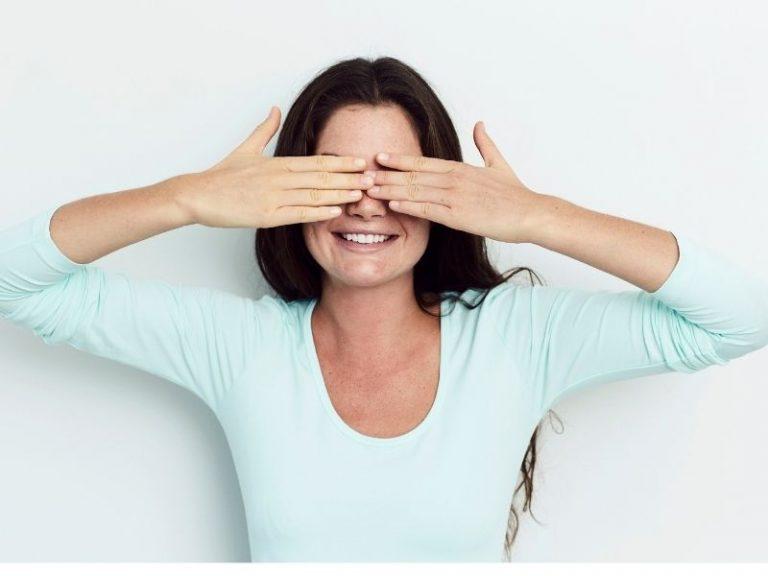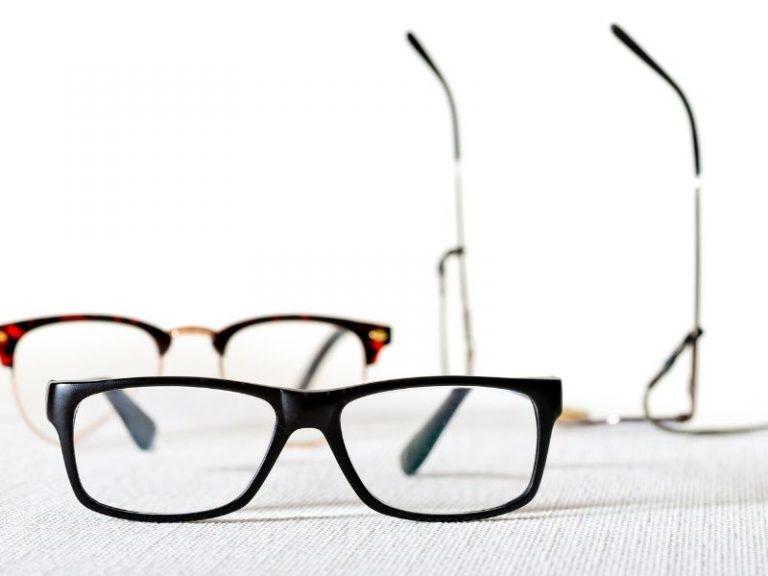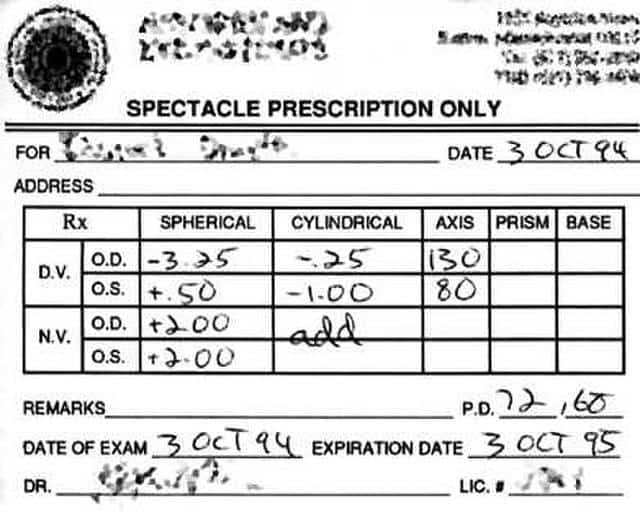Astigmatism 101: The World in the Eyes with Astigmatism
Astigmatism in one of the most common cause of refractive errors with a prevalence study concluding that a third of just the US population has the said condition. What’s surprising is that most people with mild astigmatism don’t even know they have them. So this article is about what people with astigmatism see so you may check it out yourself.
There are three distinct ways people with astigmatism can see: lights are expanding in a straight line, texts doubling either on side or top, and lines doubling either on side or top. These are the most common things people with astigmatism see.
While there are many symptoms of astigmatism, these are the ones that affects your vision. I have prepared photo illustrations to make it easier for you to compare things visually.
Source: Vitale, Susan. “Prevalence of Refractive Error in the United States, 1999-2004.” Archives of Ophthalmology, vol. 126, no. 8, 2008, p. 1111., doi:10.1001/archopht.126.8.1111.
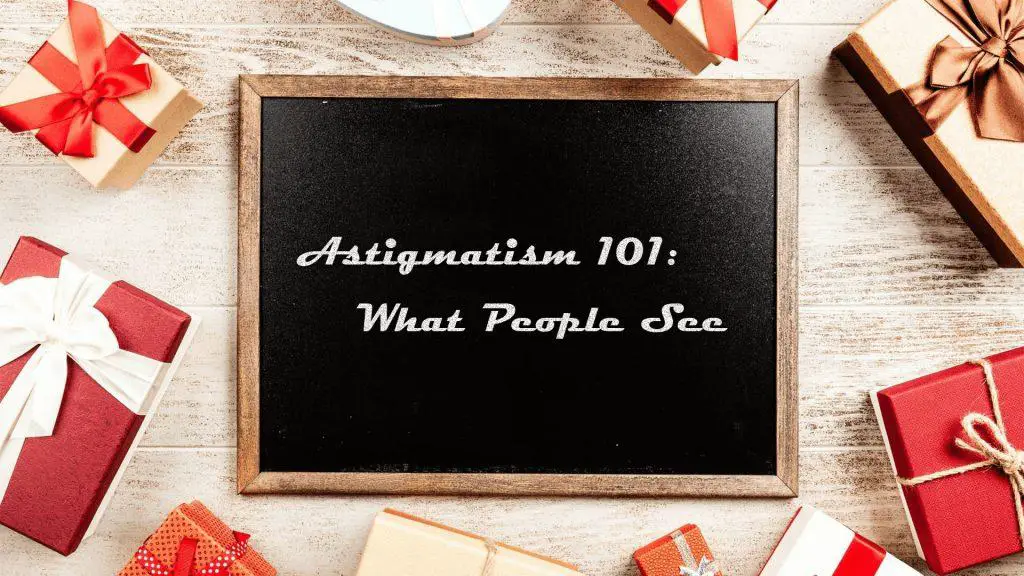
What do people with astigmatism see?
In Summary, people with astigmatism see the following: lights are expanding in a straight line, texts doubling either on side or top, and lines doubling either on side or top.
The lights expanding in a straight line is very prominent on night, leading to one of the most common things people with astigmatism experience which is poor vision at night or low lighting conditions.
Texts doubling either on side or top happens because light is not properly refracted in the eyes with people with astigmatism. This is because eyes with astigmatism usually have a football shape cornea unlike the normal which is baseball shaped.
The reason for this is that astigmatism is an error in the curvature of the eyes unlike myopia and presbyopia which affects the shape of the eyeball.
Lines doubling either on side or top also happens because of refracting issues. Things may seem blurry for people with astigmatism but the truth is, there is just some sort of doubling of lines because of astigmatism.
People who are 20/20 can have astigmatism and also, people who are myopic or have hyperopia might also have astigmatism.
A research titled: “Astigmatism and the development of myopia in children.” Also concluded that people who are born with astigmatism has a higher likelihood to develop myopia later in their lives.
Source: Gwiazda, Jane, et al. “Astigmatism and the Development of Myopia in Children.” Vision Research, vol. 40, no. 8, 2000, pp. 1019–26. Crossref, doi:10.1016/s0042-6989(99)00237-0.
What is vision like with astigmatism?
So what do people with astigmatism see? In this section, I have made multiple photo illustrations so you can see clearly the difference on what normal eyes can see and what people with astigmatism see.
Also note that astigmatism has a variety of levels which is why what you might see here are what people with moderate to severe astigmatism can see. In actuality, most people who are less than 0.6 diopters in astigmatism are considered normal.
Here is a table showing the various levels corresponding to grades of astigmatism:
| Astigmatism in Diopters | Level of Astigmatism |
| <0.6 Diopters | Normal |
| 0.6 – 2.0 Diopters | Mild Astigmatism |
| 2.0 – 4.0 Diopters | Moderate Astigmatism |
| >4.0 Diopters | Severe Astigmatism |
1. What do lights look if you have astigmatism?
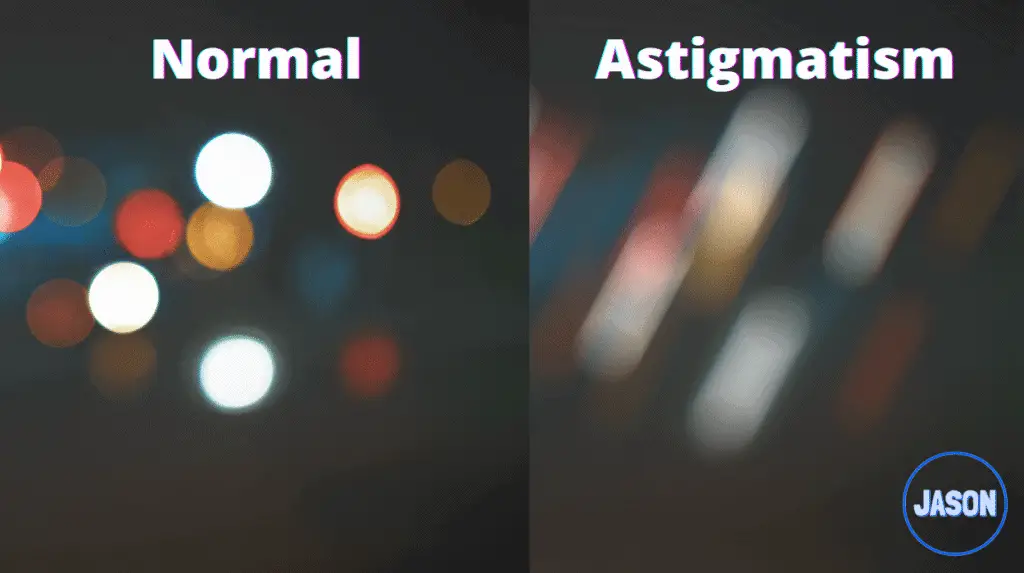
One of the key things people with astigmatism have trouble is their poor night vision. Which is the case because people with astigmatism see light expanding in a straight line. Causing them to not see well at night. It is also worthy to take note that the angle of the lights expanding varies depending on their astigmatism.
As what you can see from the image above, lights with a normal eyes are not expanded. But with people with astigmatism, it is a different story. Since lights are expanding like that, it will be hard for them to see at night.
Even as little as 1.0 diopters in astigmatism can cause a significant reduction in the person’s quality of life as said in a research: “Effect of Uncorrected Astigmatism on Vision.”
Source: Wolffsohn, James S., et al. “Effect of Uncorrected Astigmatism on Vision.” Journal of Cataract and Refractive Surgery, vol. 37, no. 3, 2011, pp. 454–460., doi:10.1016/j.jcrs.2010.09.022.
2. What do texts look if you have astigmatism
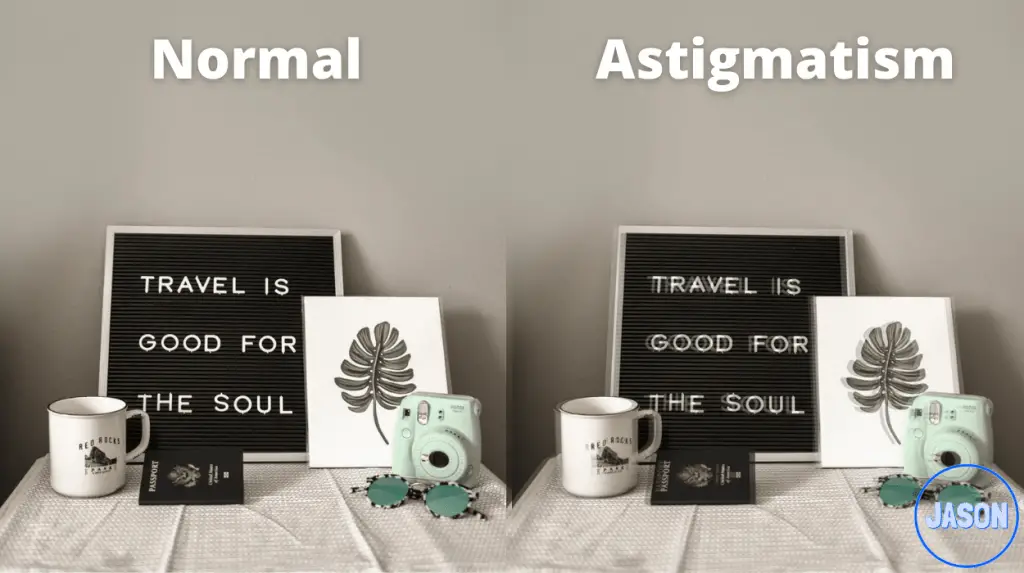
People with astigmatism see texts in a doubling like manner. It is either on the side or on top depending on the type of astigmatism.
As you can see in the text, people with astigmatism see things that looks blurry but in actuality, people with astigmatism see texts that looks like doubling.
That is why people with 20/20 vision can still have astigmatism. The blur happening is not caused by elongated or short eyeballs. Even with 20/20, they might see things blurry because of astigmatism.
One thing to point out is that astigmatism affects vision in all distances. While myopia affects only distant vision and hyperopia on things that are near.
3. What do lines look if you have astigmatism

As you can see in the image here, lines are very much affected with astigmatism because of the characteristic “double” lines.
People with astigmatism will find it harder to look at straight lines and look for the texts which is why people with severe astigmatism can have trouble finding out the object’s real location.
Also, as you can see in the images above, since people with astigmatism see things doubling, most people with astigmatism suffer from eye fatigue or discomforts. That is why dizziness is a common occurrence with people with uncorrected astigmatism.
Other symptoms of astigmatism are as follows:
- Eye discomforts such as headache or dizziness
- Eye squinting especially when looking at texts
- Blurry Vision or having blur on some areas only
- Poor Night Vision
- Eye Strain
What’s the Difference with Astigmatism and Nearsightedness / Farsightedness
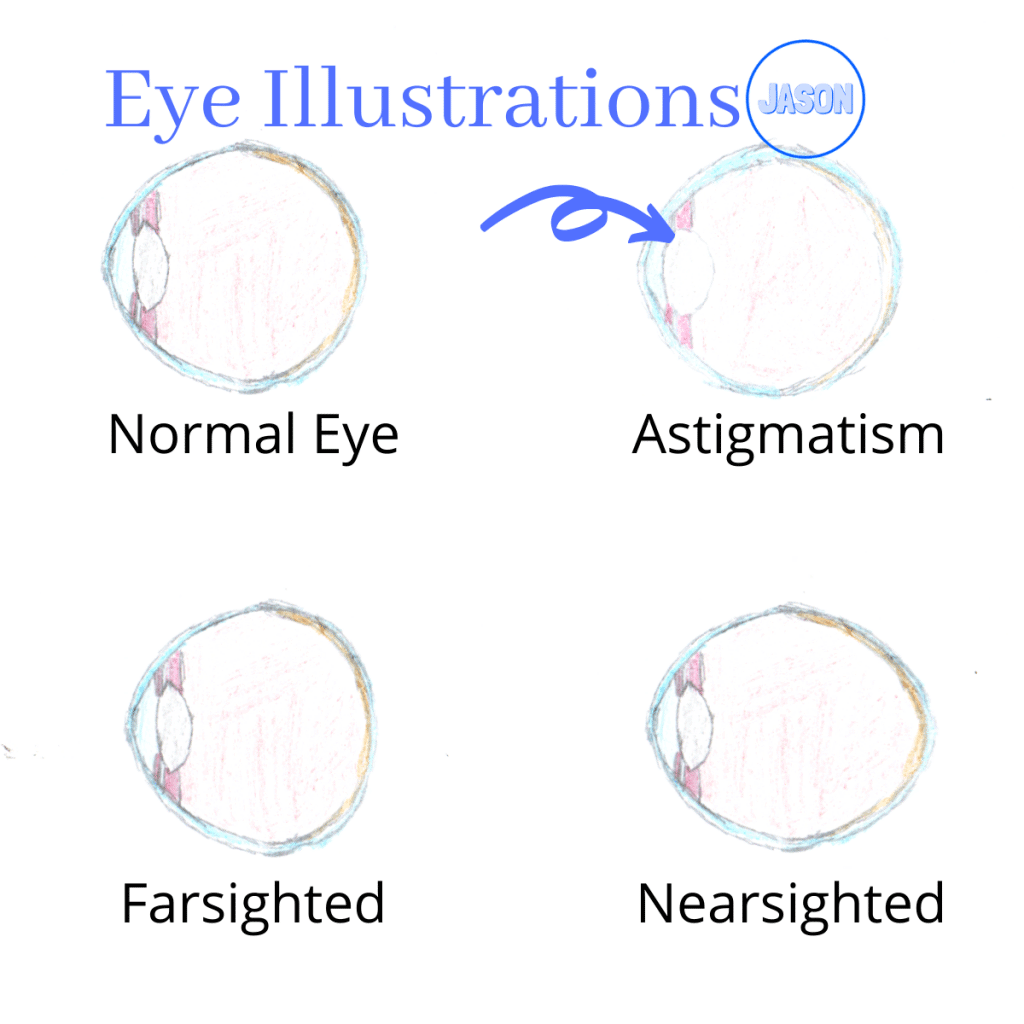
People with astigmatism have a distorted vision in all distances while people with myopia only has distorted vision on far away object. People with hyperopia or farsightedness have a poor vision on near object. Another point in terms of the eyeballs is that while nearsighted or farsighted affects the shape of the eyes, astigmatism affects the curvature of the eyes.
Since astigmatism only affects the curvature of the eyeball and not the shape, it is not affected by the distance of the object people are looking at.
The curvature problem can be either of the two parts of the eyes. One is the cornea which is the outer portion of the eyes and the other is the lens which is pointed by the arrow in the image above.
Either of these two can cause light to refract in a wrong manner resulting to astigmatism.
How do You Know if You Have Astigmatism
Checking your vision at night and eye strain or discomforts such as dizziness are the most common things to look out for when you have astigmatism.
Checking your vision at night if perfect as most people with astigmatism experience poor night vision. It is also very easy to find out unlike the others.
While there are many more symptoms of astigmatism, the night vision is the easiest to check. Plus the visuals shown above will also help for you to determine if you have astigmatism or not.
You can also have astigmatism if you always experience eye discomforts such as dizziness and nausea or frequent eye squinting.
If that is the case, consult a specialist so you can have the right prescription, diagnosis and treatment depending on what your condition is.
The Easiest Way to Find Out If You Have Astigmatism
The easiest way to find out of you have astigmatism is to check your vision at night. People with astigmatism always have a very hard time to look at night because it is a light refractive error. Checking your vision at night is the fastest, easiest and free way to easily check if you have astigmatism.
Lights look like expanding in a straight line on people with astigmatism. This causes them to see things more brighter than usual and makes your eyes adjust to it. This causes them to not see well at night because lights are so enhanced that they can’t see well.
You can try this experiment if you are interested:
- Open the lights in your room at night – This means that your eyes will adjust to the light around you making it less sensitive to light.
- Close the lights immediately – A few seconds after closing the lights, you will experience that you really can’t see well in the dark. This is because your eyes are less sensitive to light because it has adjusted to the environment with a lot of light. People with astigmatism is more likely in that condition for long because lights look enhanced because of the refractive error.
Here is a more detailed article to know if you have astigmatism or your astigmatism is getting worse. It is on point and will be good to pair up with this article. Check it out!
Should you Wear Glasses if you have Astigmatism?
Wear glasses for astigmatism if you are experiencing discomforts such as eyestrain due to uncorrected astigmatism. Another reason to wear glasses is if you are working in a detail oriented work. This is because people with astigmatism has hard time looking at the details.
In fact, a research by the Journal of Cataract and Refractive Surgery concluded that Even as little as 1.0 diopters in astigmatism can cause a significant reduction in the person’s quality of life.
Source: Wolffsohn, James S., et al. “Effect of Uncorrected Astigmatism on Vision.” Journal of Cataract and Refractive Surgery, vol. 37, no. 3, 2011, pp. 454–460., doi:10.1016/j.jcrs.2010.09.022.
It is also note worthy to take note that not wearing glasses will not affect astigmatism whatsoever, be it making it better or worse. A research titled: “Reduction of Astigmatism after Infancy in Children Who Did and Did Not Wear Glasses and Have Strabismus.” says that they found no significant correlation between astigmatism and glasses which means that you can decide to wear it or not.
In fact, most people who have astigmatism don’t even know it. Remember that 0.6 diopters in astigmatism is even considered normal according to Dr. Ali Moshirfar, MD.
But it is recommended to get a proper checkup so you will know your current eye grade and to see if not wearing glasses is reducing the quality of life you have. Remember that just a 1.0 diopter astigmatism can cause significant decrease on a person’s quality of life.
Source: Ingram, R.M., et al. “Reduction of Astigmatism after Infancy in Children Who Did and Did Not Wear Glasses and Have Strabismus.” Strabismus, vol. 9, no. 3, 2001, pp. 129–135., doi:10.1076/stra.9.3.129.6762.
Other than that, if you are not working in a detail oriented environment, it is perfectly fine to not use glasses for astigmatism. If you are not experiencing eye fatigue or headaches then it is fine to do so.
But as always, it is the best to check with a specialist to get a proper diagnosis.
Does astigmatism get worse with age?
Aging causes astigmatism to get worse. In fact, aging causes astigmatism to get worse by 1.0 diopter every decade after 50. The decreasing pressure in your eyelids due to aging can affect the shape of the cornea, leading to worsening astigmatism due to age. But astigmatism remains stable until 50 years of age
Before age 50, astigmatism remain stable. A research conducted in Acta Ophthalmologica concluded so. Also, it also concluded that astigmatism gets worse by 1.0 Diopter every decade of life after 50.
Sanfilippo, Paul G., et al. “Distribution of Astigmatism as a Function of Age in an Australian Population.” Acta Ophthalmologica, vol. 93, no. 5, 2015, pp. e377–85. Crossref, doi:10.1111/aos.12644.
It is also worth taking that newborns also have some sort of astigmatism. In short, astigmatism is affected by the growth of the eyeballs and aging.
There are many more factors that can affect astigmatism. It may be caused by an underlying condition and should be checked by a qualified health professional. If you are experiencing the following, it is better to get a proper checkup:
- Vision is Getting Worse at a very fast rate
- You are experiencing discomforts such as headaches
- You have an underlying condition such as diabetes
If you are experiencing these, better get a proper checkup.

“Only the things I love“
ongjason.com is reader-supported. When you buy through links on the site, I earn an affiliate commission.
I believe that tools are essential, especially in improving our lifestyle. Because I am a minimalist, I only buy things that add value to my life.
In this part, I will give you the tools I use for improving my eyesight.
Myopia Calculator
First, let’s start with something free. The Myopia Calculator is something I’ve personally made for my viewers.
Go to the Myopia Calculator I’ve coded, which will give you the details you need to start print pushing and active focusing.
I also have video instructions in that blog post, making it easier to use the tool.
Active Focusing Full Course!
So you want to do active focusing but don’t know how? I got you covered with a completely free course!
You can visit the course here: Improve Eyesight Fast: Full tutorial with Proof.
My Story
Alright, who am I giving tips on how to reduce your eye grade? What’s my story?
You can find my whole story here: How I reduced my Myopia
YouTube
Another free tool where you can learn more about eyesight is on YouTube.
While I do not make eyesight videos anymore, many YouTubers are out there that teach how to reduce your eyesight.
However, I am not one of them.
Of course, if you want to follow me, you can find my Channel by clicking the button below.
Tape Measure
Have a suitable measuring device. I don’t recommend cloth or simple tape measures since you must always stretch it hard when measuring.
Get a simple heavy-duty tape measure since you need to pull it out. You can also see that I’m using this measuring device in my videos.
Blue Light Glasses
Okay, one of the things you will learn from me is that preventing eye strain means getting enough sleep. Guess what? Blue light affects our sleep a lot.
That’s why I recommend wearing Blue Light Glasses at night about 2 hours before bedtime. That way, you will be sleepy enough and have a good night of sleep.
I use a yellow-colored one since it blocks the majority of blue light.
Reading Glasses/ Positive Lens
A quick warning. Do not use a positive lens if your eye grade is more than -2.00. You do not need one if your eye grade is still high.
But always get a good quality pair of these glasses since low-quality pair of positive lenses might not be very accurate.
Furthermore, some of these cheap pairs are not optical grade, which means their surface is not smooth. Non-optical grade glasses confuse the eyes.
If you are in the last stages of print pushing (-2.00 below), don’t waste your efforts by having a low-quality positive lens.
While there is a simple test for checking positive lens quality, it would be better to ensure that you have a high-quality lens.
So I recommend this positive lens which is lightweight, scratch-resistant, and accurate.
Negative Lens/ Myopia Glasses
This is one of the problems of most of my viewers; however, I’m sorry, but as of this time, I can’t give you recommendations on where to buy a pair online.
I am just lucky to befriend an optometrist who helped me get the grade I want. Let’s see in the future if I find anyone that would offer to help us get one online.
Of course, I will check their quality myself before recommending anything.
If you know someone who can help the community, go to my contact page and email me.


